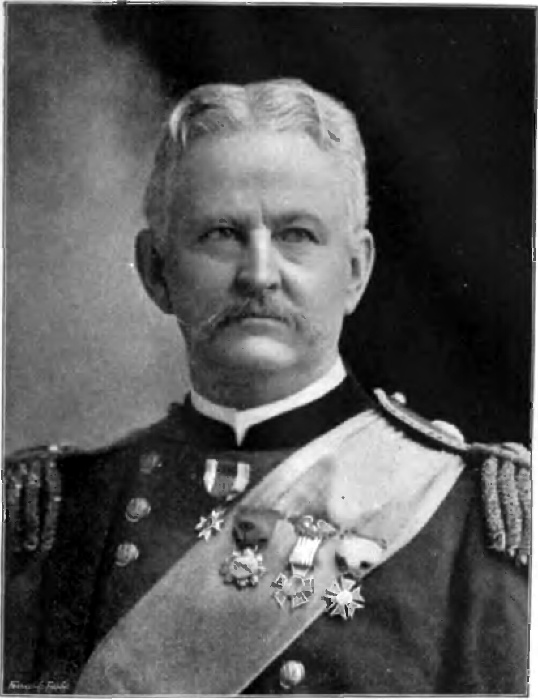During the Spanish-American War, U.S. Army major general Wesley Merritt commanded VIII Corps, the expeditionary force sent to the Philippines.
Wesley Merritt
Birth Date: June 16, 1836
Death Date: December 10, 1910
U. S. Army officer.
Wesley Merritt was born in New York City on June 16, 1836. He attended the United States Military Academy, West Point, graduating in the middle of his class in 1860. Following graduation, he served in Utah with the 2nd Dragoons. The American Civil War brought Lieutenant Merritt’s transfer to the East. There he turned out to be a superb cavalry officer. As a captain, he distinguished himself in the Gettysburg Campaign in the Battle of Brandy Station (June 9, 1863), the largest cavalry engagement in the history of North America. Receiving further notice, he was breveted brigadier general of volunteers and commanded the reserve cavalry of the Army of the Potomac.
Assigned temporary command of a division in May 1864, Merritt again fought with distinction in the Battle of Todd’s Tavern on May 7, the largest dismounted cavalry engagement of the war. Following further distinguished service, especially the Battle of Yellow Tavern on May 11, he received permanent command of the 1st Cavalry Division of Sheridan’s Army of the Shenandoah, leading it in a number of important Union victories. During the Appomattox Campaign of April 1865, Merritt commanded the Cavalry Corps as a brevet major general of Volunteers.
Following the Civil War, Merritt remained with the regular army as a lieutenant colonel and commander of the 9th Cavalry Regiment, one of two African American regiments in the army. This began 17 years of service on the frontier and extensive fighting against hostile Native Americans in the West. In 1876, he received promotion to colonel and took command of the 5th Cavalry Regiment, fighting in the Great Sioux War of 1876, the pursuit of the Nez Perce and in the Bannock War (1877-1878), and the Ute War (1879).
In 1882, Merritt became superintendent of West Point, serving in that position until his promotion to brigadier general in 1887. He then assumed command of the Department of the Missouri at Ft. Leavenworth, Kansas. From 1895 to 1897, he commanded the Department of the Missouri, the Department of Dakota, and Department of the East, respectively. In 1893, he wrote a book, The Armies of Today. In the book and in articles, he advocated a large and modern regular U. S. Army. He also supported U. S. imperial expansion.
Nearing retirement age at the beginning of the Spanish- American War, Major General Merritt was the second-ranking officer in the army. On the outbreak of war, he asked for command of VIII Corps. Appointed to that position on May 12, he was informed that the corps would be headed to the Philippines. On May 19, he received his instructions to defeat the Spanish, pacify the islands, and hold them for the United States but not to ally his forces with those of Filipino insurgent leader Emilio Aguinaldo y Famy. Although the instructions left vague the future of the islands, Merritt assumed that they would be annexed by the United States.
Merritt did what he could to organize his corps prior to departure, making it a point to secure suitable tropical uniforms and supplies for the soldiers, which may have reduced deaths from heat-related illness and disease. He sailed for the Philippines in the Newport, departing San Francisco on June 29 and arriving at Manila in late July.
Styling Aguinaldo a “Chinese half-breed adventurer,” Merritt followed his instructions of operating independently of the insurgent forces, which had surrounded Manila. Rear Admiral George Dewey negotiated with the Spanish commander, General Fermin Jaudenes y Alvarez, agreeing to stage a small symbolic battle on August 13 to satisfy Spanish honor while at the same time excluding the Filipino revolutionaries. The occupation of Manila on August 14 proceeded smoothly, and Merritt’s troops quickly established order in the city. He issued a proclamation promising support and protection to all those cooperating with the U. S. troops.
On August 30, Merritt transferred command of VIII Corps to Major General Elwell S. Otis and departed the islands for Paris to brief the U. S. peace commissioners meeting with their Spanish counterparts in Paris. There, Merritt told the commissioners that it was his opinion that the United States should annex the Philippines and that the majority of Filipinos would welcome American rule.
In December 1898, Merritt assumed command of the Department of the East. He retired from the army in 1900 and died in Natural Bridge, Virginia, on December 10, 1910.
Further Reading Alberts, Don E. Brandy Station to Manila Bay: A Biography of General Wesley Merritt. Austin, TX: Presidial, 1980. Cosmas, Graham A. An Army for Empire: The United States Army in the Spanish-American War. College Station: Texas A&M University Press, 1994. Linn, Brian McAllister. The Philippine War, 1899-1902. Lawrence: University Press of Kansas, 2000. Feuer, A. B. America at War: The Philippines, 1898-1913. Westport, CT: Praeger, 2002. Trask, David F. The War with Spain in 1898. Lincoln: University of Nebraska Press, 1996.
